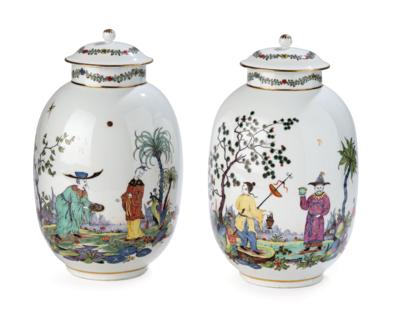Adam Friedrich von Löwenfinck, Rare Pair of Vases, Meissen, c. 1740
porcelain, with polychrome painted decoration, two covered vases with all-round chinoiserie scenes, height 28.5 cm, underglaze blue crossed swords mark, (GO)
Adam Friedrich von Löwenfinck is regarded as one of Meissen's most idiosyncratic ceramic painters. He developed his own style at a young age, which was characterised by confident lines, his own colour scale and great freedom and originality in the composition. He began an apprenticeship at the Meissen Porcelain Manufactory in 1727 at the age of thirteen, under the direction of Johann Gregorius Höroldt. In 1734 he became a journeyman and was commissioned with demanding work. Löwenfinck left the manufactory due to disputes with his master Johann Gregorius Hoeroldt. Two years later, he fled to Bayreuth, subsequently to Ansbach and in 1741 to Fulda. In 1746, together with Johann Christoph Göltz, he became the founder of the Höchst Porcelain Manufactory in Höchst am Main and was subsequently head of the Hannong Faience Manufactory until his death in 1740.
The imaginative mythical creatures are among the most important motifs of the Meissen manufactory painter Adam Friedrich von Löwenfinck, who was influenced by the world of mythical beasts surrounding the exotic creatures of East Asian culture such as quilins, foo dogs and dragons. Löwenfinck's painting is characterised by an ingenious inventiveness and an expressive, individual style, which is enhanced by the dazzling luminosity of the colours.
Löwenfinck's painting is characterised by an ingenious inventiveness and an expressive, individual style, which is enhanced by the dazzling luminosity of the colours.
The style is based on prints by Augsburg publishers such as Elias Baeck (1669-1747), Martin Engelbrecht (1684-1756), Johann Christoph Weigel (1654-1725) and Jeremias Wolff (1663-1747) and in particular on the prints published in Amsterdam and Leipzig by Petrus Schenk and his son, who was also called Petrus. The series "Nieuwe geinventeerde Sineesen" was already known in Meissen as early as the 1720s, becoming a popular source in the late 1730s.
Specialist: M.A. Georg Ottomeyer
 M.A. Georg Ottomeyer
M.A. Georg Ottomeyer
+43-1-515 60-538
georg.ottomeyer@dorotheum.at
25.04.2024 - 13:00
- Estimate:
-
EUR 40,000.- to EUR 70,000.-
Follow Remove
Adam Friedrich von Löwenfinck, Rare Pair of Vases, Meissen, c. 1740
porcelain, with polychrome painted decoration, two covered vases with all-round chinoiserie scenes, height 28.5 cm, underglaze blue crossed swords mark, (GO)
Adam Friedrich von Löwenfinck is regarded as one of Meissen's most idiosyncratic ceramic painters. He developed his own style at a young age, which was characterised by confident lines, his own colour scale and great freedom and originality in the composition. He began an apprenticeship at the Meissen Porcelain Manufactory in 1727 at the age of thirteen, under the direction of Johann Gregorius Höroldt. In 1734 he became a journeyman and was commissioned with demanding work. Löwenfinck left the manufactory due to disputes with his master Johann Gregorius Hoeroldt. Two years later, he fled to Bayreuth, subsequently to Ansbach and in 1741 to Fulda. In 1746, together with Johann Christoph Göltz, he became the founder of the Höchst Porcelain Manufactory in Höchst am Main and was subsequently head of the Hannong Faience Manufactory until his death in 1740.
The imaginative mythical creatures are among the most important motifs of the Meissen manufactory painter Adam Friedrich von Löwenfinck, who was influenced by the world of mythical beasts surrounding the exotic creatures of East Asian culture such as quilins, foo dogs and dragons. Löwenfinck's painting is characterised by an ingenious inventiveness and an expressive, individual style, which is enhanced by the dazzling luminosity of the colours.
Löwenfinck's painting is characterised by an ingenious inventiveness and an expressive, individual style, which is enhanced by the dazzling luminosity of the colours.
The style is based on prints by Augsburg publishers such as Elias Baeck (1669-1747), Martin Engelbrecht (1684-1756), Johann Christoph Weigel (1654-1725) and Jeremias Wolff (1663-1747) and in particular on the prints published in Amsterdam and Leipzig by Petrus Schenk and his son, who was also called Petrus. The series "Nieuwe geinventeerde Sineesen" was already known in Meissen as early as the 1720s, becoming a popular source in the late 1730s.
Specialist: M.A. Georg Ottomeyer
 M.A. Georg Ottomeyer
M.A. Georg Ottomeyer
+43-1-515 60-538
georg.ottomeyer@dorotheum.at
|
Buyers hotline
Mon.-Fri.: 9.00am - 6.00pm
kundendienst@dorotheum.at +43 1 515 60 200 |
| Auction: | Furniture, Works of Art, Glass & Porcelain |
| Auction type: | Saleroom auction with Live Bidding |
| Date: | 25.04.2024 - 13:00 |
| Location: | Vienna | Palais Dorotheum |
| Exhibition: | 13.04. -25.04.2024 |

